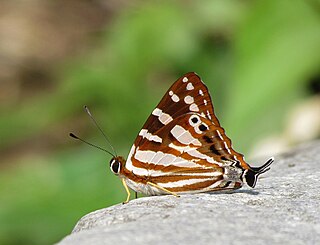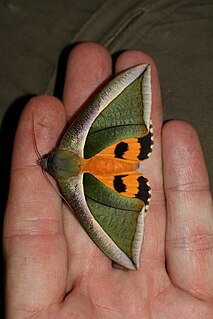
Dodona egeon, the orange Punch, is a small but striking butterfly found in the Indomalayan realm - in Mussoorie to Assam, Burma (nominate) and Peninsular Malaya that belongs to the family Riodinidae.

Appias lalage, the spot puffin, is a small butterfly of the family Pieridae, that is, the yellows and whites, which is found in India, Indochina and Hainan.

Miletus boisduvali, the common brownie, is a small but striking butterfly found in India and Myanmar that belongs to the lycaenids or blues family.

Junonia hierta, the yellow pansy, is a species of nymphalid butterfly found in the Palaeotropics. It is usually seen in open scrub and grassland habitats.

Eudocima salaminia, the green fruit-piercing moth, is a moth of the family Erebidae. The species was first described by Pieter Cramer in 1777. It is found from India, and across south-east Asia to the Pacific Islands. In Australia it occurs in the Northern Territory, Queensland and New South Wales. The adult is a fruit piercer.
Spidia inangulata is a moth in the family Drepanidae. It was described by Watson in 1965. It is found in Cameroon and Nigeria.
Spidia planola is a moth in the family Drepanidae. It was described by Watson in 1965. It is found in Ivory Coast and Sierra Leone.
Compsolechia repandella is a moth of the family Gelechiidae. It was described by Francis Walker in 1864. It is found in Mexico, Colombia, southern Brazil and Guyana.
Compsolechia incurva is a moth of the family Gelechiidae. It was described by Edward Meyrick in 1914. It is found in Guyana, Brazil and Peru.
Compsolechia praenivea is a moth of the family Gelechiidae. It was described by Edward Meyrick in 1914. It is found in Guyana.
Compsolechia sporozona is a moth of the family Gelechiidae. It was described by Edward Meyrick in 1914. It is found in Guyana, Brazil and Peru.
Compsolechia caryoterma is a moth of the family Gelechiidae. It was described by Edward Meyrick in 1922. It is found in Amazonas, Brazil.
Compsolechia crocodilopa is a moth of the family Gelechiidae. It was described by Edward Meyrick in 1922. It is found in Peru and Pará, Brazil.
Compsolechia diplolychna is a moth of the family Gelechiidae. It was described by Edward Meyrick in 1922. It is found in Pará, Brazil.
Compsolechia eurygypsa is a moth of the family Gelechiidae. It was described by Edward Meyrick in 1922. It is found in Peru.
Compsolechia loxogramma is a moth of the family Gelechiidae. It was described by Edward Meyrick in 1922. It is found in Amazonas, Brazil.
Compsolechia sesamodes is a moth of the family Gelechiidae. It was described by Edward Meyrick in 1922. It is found in Brazil and Peru.
Compsolechia trochilea is a moth of the family Gelechiidae. It was described by Walsingham in 1910. It is found in Mexico (Tabasco).
Compsolechia crescentifasciella is a moth of the family Gelechiidae. It was described by Vactor Tousey Chambers in 1874. It is found in North America, where it has been recorded from Texas.
Antaeotricha bicolor is a species of moth of the family Depressariidae. It is found in Brazil.




